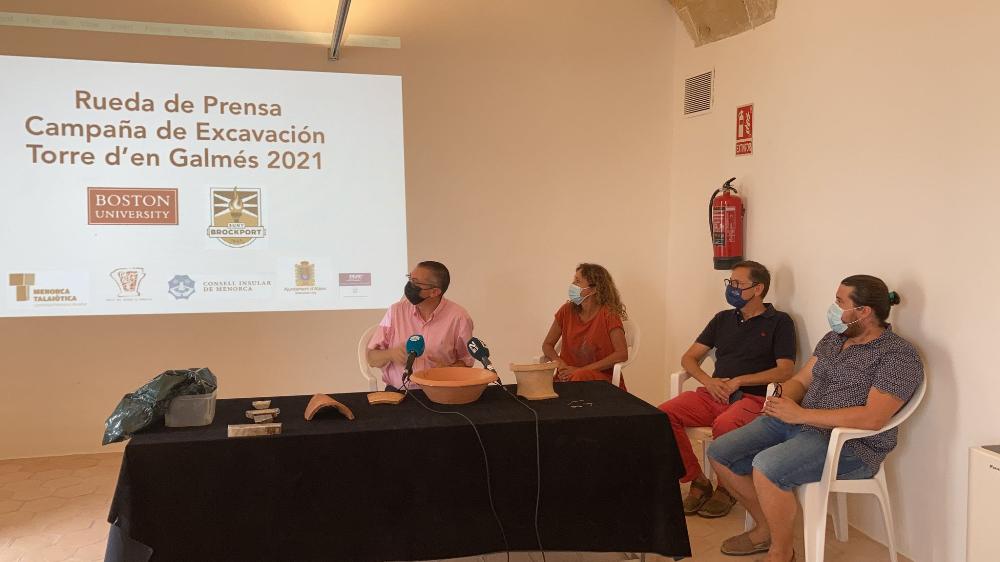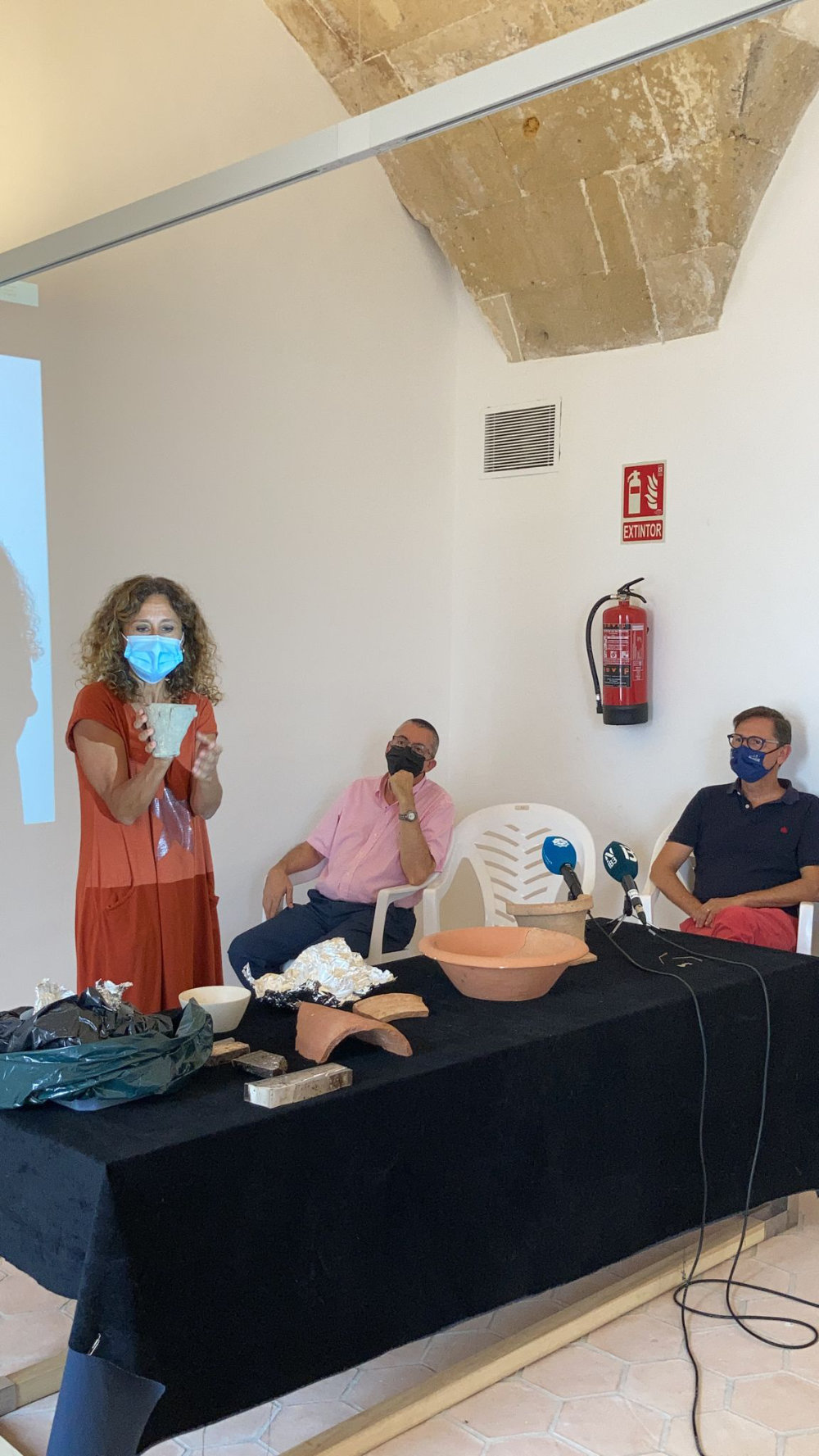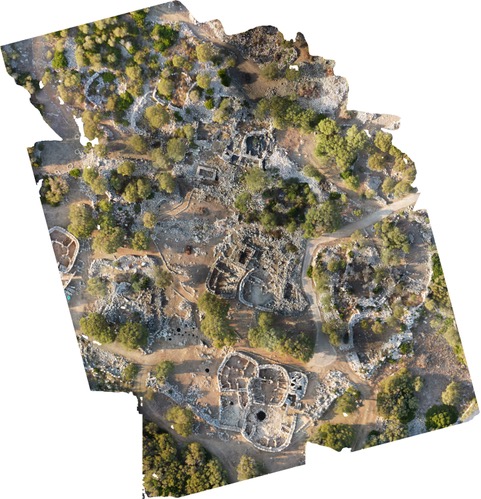 Today, August 30, the San Diego convent in Alaior hosted a presentation of the results of the archaeological campaign at Torre d'en Galmés (2021) by Boston University and SUNY Brockport. The archaeologists, Amalia Pérez-Juez Gil and Bruno Parés Sansano, showcased part of the recovered material, aerial photographs, and a 3D reconstruction of a portion of the site. The Vice President and conseller of Cultural Affairs, Miquel Àngel Maria, a representative of the Alaior City Hall, Santiago Reurer, and the president of Amics del Museu de Menorca, Cecilia Ligero, all attended the event.
Today, August 30, the San Diego convent in Alaior hosted a presentation of the results of the archaeological campaign at Torre d'en Galmés (2021) by Boston University and SUNY Brockport. The archaeologists, Amalia Pérez-Juez Gil and Bruno Parés Sansano, showcased part of the recovered material, aerial photographs, and a 3D reconstruction of a portion of the site. The Vice President and conseller of Cultural Affairs, Miquel Àngel Maria, a representative of the Alaior City Hall, Santiago Reurer, and the president of Amics del Museu de Menorca, Cecilia Ligero, all attended the event.
The 2021 archaeological campaign was led by professors from Boston University and SUNY Brockport: Amalia Pérez-Juez, Alexander Smith, Paul Goldberg and Ricardo Elia. A large team of professionals from different institutions and disciplines also participated, including individuals from Menorca, Mallorca, Barcelona, and Madrid, as well as North American students. As in previous years, the team also collaborated with the Amics del Museu de Menorca. The campaign, financed by the home institutions of the team members as well as by the Consell Insular de Menorca, produced interesting results concerning the Andalusian occupation of the Talayotic site.
 The objective of the 2021 campaign was to continue studying the 12th and 13th century Andalusian reoccupation of Torre d'en Galmés. Where did the new population settle? How did they take advantage of the site’s resources? Did they modify the Talayotic structures? Did they use Talayotic cisterns and caves? In order to answer these questions, the team continued excavations of the site’s central area, where we know there were at least five domestic enclosures, which were composed of two to three rectangular rooms arranged in an L or U shape around a patio.
The objective of the 2021 campaign was to continue studying the 12th and 13th century Andalusian reoccupation of Torre d'en Galmés. Where did the new population settle? How did they take advantage of the site’s resources? Did they modify the Talayotic structures? Did they use Talayotic cisterns and caves? In order to answer these questions, the team continued excavations of the site’s central area, where we know there were at least five domestic enclosures, which were composed of two to three rectangular rooms arranged in an L or U shape around a patio.
The first structure the team focused upon was SPU 9, which was excavated in previous years, and where a Talayotic cistern had been located. The Muslims built their house right on the edge of the cistern and constructed a spout that fed into the well, most-likely using the system to collect rainwater from the roof. All the sediment in the cistern was floated for analysis in the laboratory. The presence of traces of grain -in this case barley- and fauna -showing a significant number of fishbones- have already been detected at the site. Right next to SPU 9 is another Andalusian house enclosure formed by at least two rooms around an open patio. All the houses were plastered with lime on the inside and covered with ceramic roof tiles.
The team also began excavation of a new medieval structure -SPU 7- that is located to the south of the taula sanctuary. It is part of a larger enclosure, most-likely formed by three rooms in a U-shape around a central patio. The team excavated half of SPU 7 to assess the stratigraphy and understand how it was built in relation to Talayotic structures. The stratigraphic sequence is more complicated than in previously excavated structures because there is no clear collapse level. It was shown, however, that the medieval room rises directly above a Talayotic level, in which an intact high-bottomed cup was found, a vessel that is traditionally dated between the 3rd and 2nd centuries BC. These cups have been related to ritual activities and would be used for libations, offerings, etc., or even for some rituals associated with structural foundations.
The Andalusian material found (cooking and serving ceramics, such as ataifores -big serving plates- and jugs) are very similar to the ones recovered during previous campaigns and confirms an intensive occupation of the site in the 12th and 13th centuries as mentioned above. The lab analyses carried out during 2021 include the flotation of sediment from all stratigraphic units and radiocarbon dating. Samples were also taken from all stratigraphic units to analyze thin sections of soil micromorphology. This methodology will allow us to better understand the nature of all the excavations and make a more detailed study of the microstratigraphy. Finally, the project used photogrammetry and 3D reconstruction for all the excavated spaces.
To conclude, each year we understand a little more about the Andalusian community that settled at the Talayotic site of Torre d’en Galmés between the 12th and 13th centuries, and thereby approach a part of Menorcan history that is so important in understanding the current landscape of the island.
 Here you can see a video of the 3D reconstruction of part of the site.
Here you can see a video of the 3D reconstruction of part of the site.